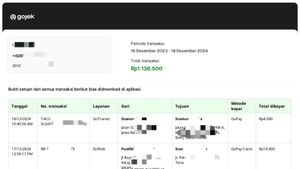JAKARTA - Even though Tanah Abang Market currently holds the status of the largest textile wholesale center in Southeast Asia, still, for people born and raised as Betawi people, the existence of Tanah Abang is closely related to the existence of martial arts masters, aka champions. For them, Tanah Abang Market is home.
The market, which was built by a wealthy VOC official named Justinus Vinck in 1935, was originally only open on Saturdays. Even the buying and selling activities carried out are still limited to selling textiles and groceries.
Even so, his activities were able to invite the presence of many people, be it traders of Chinese descent, indigenous traders, Europeans, to martial arts masters who were looking for sustenance in the market that stood on the former land of the famous landlord in Batavia, Cornelis Chastelein.
At that time, the initial conditions for the market were still modest. Only, thatch roofs and walls of bamboo or woven bamboo. However, Tanah Abang Market remains special. Its development played a big role in the development of a small civilization in the surrounding villages.
GJ Nawi, author of the book Maen Pukul: Pencak Silat Khas Betawi (2016), explains how Tanah Abang Market is a place to accommodate an abundance of local garden products, such as Kebon Kacang, Kebon Melati, Kebon Nutmeg, and others. The whole kebon is now the name of the village.
For the 'jago', Tanah Abang Market becomes a wetland to earn a living. Not just one, but dozens of champions with the nuances of the diversity of silat science are in a place that was destroyed by the Pacinan riot in 1749. "This market is also a place where masters make a living. Gang Kubur Lama as the producing area is not far from Tanah Abang, ”he wrote.

Sabeni and other jago
One of the most famous names from Tanah Abang or what used to be called Tenabang is Sabeni bin Canam. He was born in Kebon Pala, Tenabang in 1860. Sabeni began to be known by people since the days of the Dutch East Indies as a figure who was not only good at silat, but because he was famous for the character and character of a knight.
As is often said in various literacies. Sabeni is a simple figure with big stature. However, this Betawi hero always looks neat in his favorite ivory (cream) clothes, complete with a hook around his neck and carries an iron like a flute that can function as a weapon.
Allegedly, Sabeni's gait became increasingly popular when he became a sarean, which in Betawi pronunciation at that time was related to the position of head of security at the onderdistrict level (sub-district). For this position, Sabeni has two confidants who are his right hand, namely H. Mansyur and Jaelani.
In fact, Sabeni's figure is different from other heroes who often have negative connotations, love to make noise, and are fierce. How could it not be, during his lifetime, Sabeni was known as someone who was patient and liked to help the little people. "So, Sabeni is not a monthly expert, he likes to give knowledge and lessons, not a murderer or an expert in payment, but he is known to have patience."

That is the lyric of the song titled History of Maen Pukul Sabeni, which was specially created by M. Ali Sabeni to commemorate his father's figure who had the character of a knight. Through a song that was popular in the 1970s with the rhythm of Gambang Kromong and accompanied by Naga Mustika, the song's owner also emphasized his father's role as the champion of Abang's land.
"If there is a sayuti who is good at Cengkareng, eh ... there is Sabeni from a good at Tenabang. There are many students and it is known that people never make cases. "
Those are the puja-puja of the child for his parents. However, Tanah Abang is not only good at Sabeni. One of the champions who have a track record of earning a fortune in Tanah Abang is Si Pitung, who is also famous as a legendary Betawi hero.
The incident was recorded by Rahmat Ali in a book entitled Betawi Folklore, Volume I (1993). It is said that one day, Pitung's father wanted to sell goats to Tanah Abang Market. Unfortunately, he was unable to attend and then asked Pitung to sell his goat.
"Wait, take these two goats to Tanah Abang. Don't give it if the price is still too cheap. Clear, man? " wrote Rahmat Ali.
After Pitung, there was another champion who had looked for sustenance at the Tanah Abang Market. As revealed by Alwi Shahab in the book Robinhood Betawi: The Betawi Story of Tempo Doeloe (2002). Alwi Shahab mentioned other sliat masters named Rachmad and Mahruf. "Their silat style is not only occupied by the youth of Tanah Abang, but also extends to other places."
Even after. Dozens of other Tanah Abang masters have been recorded in history. Call it Derachman Djeni, Habib Alwi Alhabsji and Satiri. “The last three names also have a lot of students. But Tanah Abang champions are respected and feared not because of their proficiency in martial arts, but because they are warriors and defenders of truth, as well as worship experts who do not want to stand out. "
So, it is not surprising that most of the masters are in mosques and majelis taklim. So that the masters of his time were not included in the category of thugs. If you borrow an opinion from Margreet van till the author of the book Batavia Kala Malam: Police, Bandits, and Firearms (2006). Jago has a positive connotation.
"Jago is the protector of society. In this case jago does not use their power to conquer their own territory from the official authorities, but they appear as a champion of the oppressed people, "concluded Margreet.
The English, Chinese, Japanese, Arabic, and French versions are automatically generated by the AI. So there may still be inaccuracies in translating, please always see Indonesian as our main language. (system supported by DigitalSiber.id)









